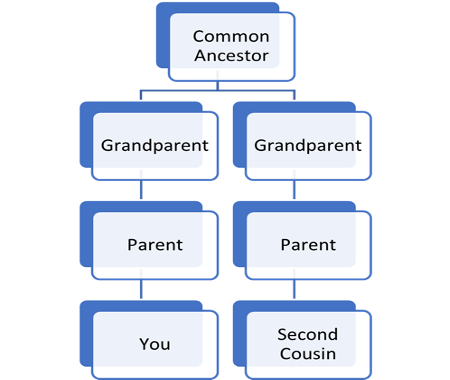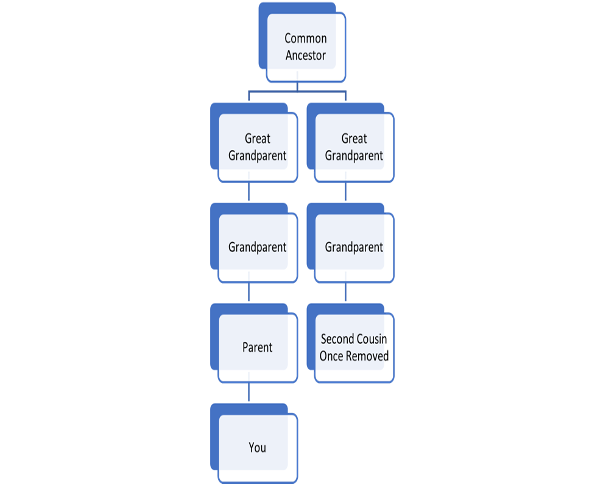What is a Second Cousin?
Are you interested to know what a second cousin is and whether you are genetically related to them? In this article, we'll help you understand what a second cousin is, whether they are considered family, and what DNA results might say.
Dealing with distant cousin relationships in your tree can be somewhat daunting especially when you start navigating between third, fourth and fifth cousin matches. The closer cousin matches, however, tend to be far easier to understand.
Ancestry is Our Top Recommendation
If you love genealogy and family history research, then you must know Ancestry. They are the best way to discover the rich stories of your family!
With over 30 billion (seriously!) records in their database, you can research your family and discover amazing details you may never have known about your ancestors.
With a 14-day free trial, it's very easy to get started and discover your past!
Get Started →Those close cousins such as first and second tend to be more prevalent to you due to the likelihood that you may actually encounter them at family gatherings. We usually know our first cousins because they are the children of our aunts and uncles but who are our second cousins?
Cousin Calculator
You can use our free cousin and common ancestor calculator tool to help you quickly understand the different relationships you have with your family tree.
What Are Second Cousins?
Quite simply, our second cousins are people with whom we share a set of great grandparents. One of our second cousins' grandparents was the sibling of one of our grandparents. This carries over with third cousins whereby our third cousins' great grandparent would be the sibling of one of our great grandparents.

Are Second Cousins Considered Family?
There is no question here second cousins are definitely considered family. They are not, however, viewed as a close family under U.S. law. Legally you could marry a second cousin whereas in about half of America’s states it is illegal to marry a first cousin.
The second cousin is in that stranger grey area whereby they are not considered a close family member nor are they a distant relative. If you lived in a small town where your family has resided for generations you are likely to know some of your second cousins.
What Is the DNA Connection?
In terms of DNA, we do not share a lot in common with our second cousins which is likely a chief reason that marrying wouldn’t be illegal. The average percentage that second cousins share is 3.13% although the range is 2-6%.
Although the percentage may be small we should share DNA with all of our second cousins. This is not always the case with third cousins who are separated by an extra generation. A third cousin may share 0-2.2% of our DNA. This is because the percentage is halved in each successive generation.
Second cousins then are the last level of cousins with whom you would definitely share some amount of DNA. A second cousin match on a site like Ancestry would then most likely be accurate although other factors may influence that as well.
| Relationship | Average % DNA Shared | Range |
|---|---|---|
| Siblings | 50% | 38% - 61% |
| First Cousin | 12.5% | 4% - 23% |
| Second Cousin | 3.13% | 2% - 6% |
| Third Cousin | 0.78% | 0% - 2.2% |
| Fourth Cousin | 0.20% | 0% - 0.8% |
How Many Second Cousins Do I Have?
Other than first cousins the number of second cousins we have on average is one of the easiest to estimate. The general average of second cousins that most people have is in the region of 28. This obviously varies.
Factors such as family size, religion and location can play a role in how many second cousins we have. We have second cousins on both sides of our family. Potentially all four of our grandparents may have siblings who themselves have grandchildren. These grandchildren make up our pool of second cousins.
Second Cousin Once Removed
We may also have second cousins who are referred to as once removed but what does this mean? A second cousin once removed may be the child of our second cousin or it could also refer to how we are related to our parents' second cousin.
The removed term applies where a second cousin relationship exists but there is a separation by one generation. As an example, to your father's second cousin you are considered their second cousin once removed.

Half Second Cousins
This relationship occurs if your great grandparent was only a half-sibling to your second cousin's great grandparent. As they shared only one parent the fact that they were only half-siblings passes down the generation with the term half and also an even lower amount of shared DNA.

Final Thoughts
The second cousin relationship is a relatively close one by which many people likely could name one or more such cousins. Second cousins share a set of great grandparents descending from the children of those common ancestors.
It is the last cousin connection that is guaranteed to be recorded in our DNA. This means that if we have a second cousin match on paper it should be reflected in our DNA to some degree.
Link To or Reference This Page
We spent a lot of time downloading, cleaning, merging, and formatting the data that is shown on the site.
If you found the data or information on this page useful in your research, please use the tool below to properly cite or reference Name Census as the source. We appreciate your support!
-
<a href="https://namecensus.com/blog/what-is-a-second-cousin/">What is a Second Cousin?</a>
-
"What is a Second Cousin?". NameCensus.com. Accessed on April 25, 2024. https://namecensus.com/blog/what-is-a-second-cousin/.
-
"What is a Second Cousin?". NameCensus.com, https://namecensus.com/blog/what-is-a-second-cousin/. Accessed 25 April, 2024
-
What is a Second Cousin?. NameCensus.com. Retrieved from https://namecensus.com/blog/what-is-a-second-cousin/.
